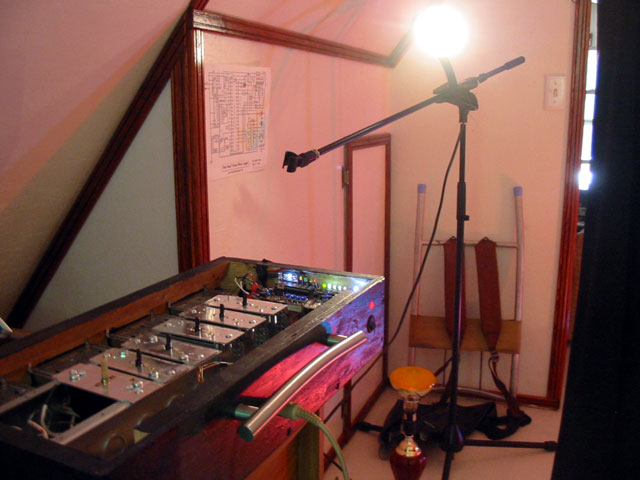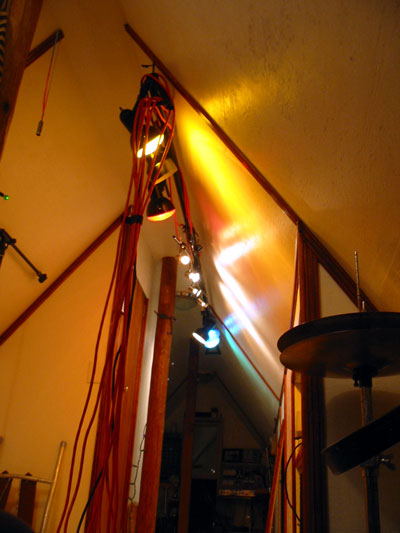Light
Sixteen (DMX) Controller
by S.Sims
| I
realised it was being caused by a phase difference between the 90 hertz
PWM rate, and the 60 hertz line frequency. So, taking the logical step, I
changed the PWM routines to sync to an isolated 60 hertz input from the
line. It worked right off, and phasing shouldn't be a problem from here on
in.
In fact, the SCR's for the <7 watt Xmas lights wouldn't have worked any other way. They still flicker a little, but that's mostly from lack of load on the SCR. I may put in some resistors to compensate, it's actually a cool effect, so I'm undecided! This photo shows the Light-16 in operation. A single picture does it no just at all so I have uploaded a video to youtube for your pleasure! (Below) I know it's not the best yet, but without dropping a couple of grand, it's the best for now. The next addition is a set of follow spots, or a moving head style light. Mine will do a vertical pan of 360º non-stop, and cover horizontal of about 30º each side. It's a top-secret design, so I won't unveil it just yet ;)
|
 |
| For a
final touch, a masked off lexan lid reveals, I couldn't help it, the Fresh
Nelly logo all backlit in 3-D. It looks way cooler in real life! Kinda 3-D
|
|
|
Mounting Bar |
||||
|
|
||||
| The bolts
act like set screws so it won't slide apart in the middle of a rockin'
show! Notice how fat the wires get there? That's so it can all come
apart without having a tangled mess of wire. Some are PC plugs & sockets
torn out of old computer power supplies, others are butchered extension cord
ends. All in all there's about 150 feet of cheap Wally world extension cord. The little fairy lights were just thrown on and wrapped around. The little light bar with the MR16 size halogens (right) was donated by our new neighbors, and the metal flood mounts (top-right photo) was donated by our neighbor Jamie. Gena donated the brown light pots, closest lights in this photo. Wow! It's so nice to have so much support, guess I better throw a dance party once it's all done. The initial test of positioning was good, although the two flood mounts are a bit too close together.
The brackets to the right are to mount the 4 strobes...uh 4/$6.95 LED flashlights that are really like strobes. And longer lasting than those xenon bulbs. The collars allow them to be rotated any direction. Now the new studio is finished, everything can be moved down there, and a better idea of the way it'll look during a performance will be at hand, for better of for worse.... Trying to figure out where to point the lights is still high on the to-do list, and the dark floor isn't going to help matters. Consider it a worse-case scenario! I've also created a couple of
VST's
to show the light notes
(not CC's) |

|
|||
|
||||
|
-
- |
||||
|
Stay tuned...
|
|
| Since
I last posted on the technical part of the project, I've added 2 really
cool features: (2) I've added something I've dubbed "Chord Magic". It's not only useful for lighting, but can be used to trigger other events in FL studio. A return MIDI line has been plugged in so the Light16 can send back MIDI note data when certain chords are sent on channel 13. This in turn can turn on patterns while in Live Mode in FL Studio. The new FL Studio 10 has for some reason removed the indicators so each sequence must be terminated by a special note ( in piano roll ) or one wouldn't know what was on or off! I have made a default .flp and everything is much easier. I have drafted up an
owners manual to give a better
idea of how everything works (and so I don't forget!!) MSoffice or WordPad
will open it. Cheers! Sandy
|
|
| I will post updates/schemas/program as soon as they are done | |
|
Oct27 2011 |
|